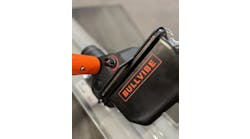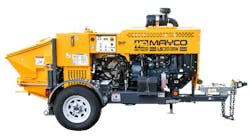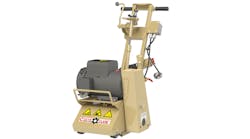Participants
Justin Odegaard, attachment product specialist, Bobcat
Dennis Hoops, director of rental, Hilti
Kris Zehren, demolition product manager, Wacker Neuson
Jeff Beck, product manager, DeWalt
RER: What are some of the latest technological developments in your breakers and with breakers in general?
Hoops: The latest technological development in Hilti breakers is the use of the brushless motor. This enables the tool to run longer between service intervals and makes the tool less sensitive to fluctuations in electrical current when used with a generator. This motor is also more tolerant of low voltage situations commonly caused from using small gauge extension cords or joining multiple cords together. Standard motors with brushes run the risk of “burning out” under low voltage situations, while a switched reluctance motor (no brushes) is, within limits, capable of running slower and designed to eventually shut itself off to minimize damage to the motor under these same conditions.
Most workers expect a lot of vibration when using a stand-up breaker. Hilti greatly reduces vibration transferred to the operator through an active vibration reduction system (AVR) that is integrated into the tool.
Zehren: Wacker Neuson's new EH 70 electric breaker utilizes 240-V power and delivers best-in-class demolition performance and power/weight ratio. The EH 70 can be used with any construction-grade 3,800-watt portable generator. This breaker was specially developed for intensive use over long periods of time. The end result is a comparatively lightweight design with demolition power and a long lifespan. The high demolition power stems from the shock-optimized percussion system, which generates 52 foot-pounds of single-stroke impact energy with an impact rate of 1,275 bpm. And it is this power, combined with a low weight of 57 pounds that gives the breaker its impressive power/weight ratio. Operators can work extremely effectively with minimum fatigue. With a hand arm vibration value below 5 m/s2, the device can be deployed to the same operators for a full day. The hood design also makes the breaker easier to handle. Its percussion system is designed for extremely low maintenance and minimum levels of wear and tear, making it an extremely cost-efficient choice. The asynchronous motor works without the usual carbon brushes and as such requires zero maintenance.
Beck: The latest technology developments that we see are regarding electronic controls, how to continue to deliver consistent performance while the tool is loaded. Our dedicated hammer design center in Idstein, Germany, is continuing to explore ways to reduce vibration and tool weight through different materials and designs.
Please give a summary of your breaker product line. What are its strengths?
Odegaard: Bobcat offers breakers in the range of 60 foot-pounds to 1,000 feet, matched to Bobcat's line of loaders and excavators. Most are designed to be quickly and easily switched between excavators and loaders. This is very beneficial for the contractor that owns or uses both on various jobs and to the rental center that rents attachments to loader and excavator operators. Operators can easily perform routine maintenance and daily checks. A multi tool, including a simple go/no-go gauge, is included with the breaker that allows operators to check the wear of the retaining pin and bushing. On most models, if the bushing has been worn beyond the normal range the operator can quickly change in the field without special tools. A range of bits are available include nail points, chisels, blunt points and tamping pads for most models. All breakers have “dry fire” protection and the power cell is suspended with shock absorbers that helps reduce vibration to the operator and machine and helps quiet the breaker.
Hoops: The Hilti breaker line starts with the TE 500, which is a small tool designed for work that is waist high or overhead such as removing wall tiles or light breaking or correction work with a bushing tool or a specialized chisel. The TE 706 AVR is the next step up in size and is used for similar applications where more power is needed. This tool is easy to control for applications like removing floor tiles or breaking out concrete around rebar on vertical walls.
The next series of tools were all developed with similar technological advancements including brushless motors, active vibration reduction, and high power-to-weight ratio. They are primarily used in a downward position for breaking up concrete and asphalt flatwork. The TE 1000 is designed for concrete approximately 4-inches thick, the TE 1500 for 6-inches thick and the all-new TE 3000 for very thick or hard concrete or breaking up large areas like driveways. In many applications, the TE 3000 performs at or above the level of a 60-pound air hammer, which is commonly used for thick concrete or large jobs.
Zehren: In 2011, Wacker Neuson will offer three electric breakers. The popular, solid-performing EH 27 electric breaker features a traditional universal motor, which utilizes 120V power, weighs 58 pounds and hits with an impact energy of 38 foot-pounds. In 2011 we will be introducing two new model breakers that utilize an asynchronous motor. This means no more replacing brushes or rotors. The new EH 60, utilizes 120V power source, weighs only 57 pounds, and hits with impact energy of 44 foot-pounds and hits the concrete at a rate of 1,275 bpm. Our EH 70 breaker utilizes a 240-V power source and has been designed for the professional contractor providing a lighter, quicker and more efficient solution for breaking concrete in a variety of applications. The EH 70 weighs only 57 pounds and hits with 52 foot-pounds of impact energy into the concrete at a rate of 1,275 bpm.
To complete our electric tool product line, we offer two handheld electric breakers and two handheld electric rotary hammer models. For the handheld electric breakers we offer a 15-pound (6-kg) breaker, which offers a single-stroke impact energy of 9 foot-pounds and a 22-pound (10-kg) breaker with a single-stroke impact energy of 14 foot-pounds. For our electric rotary hammers, our “two tools in one,” we offer a 16-pound (7-kg) rotary hammer drill, which functions as a chipper and a drill, and hits at 9 foot-pounds per blow and a 24-pound (11-kg) rotary-hammer drill that hits at 14 foot-pounds per blow.
Wacker Neuson has also enhanced our gasoline breaker. The new generation gasoline breaker, model BH 65, offers improved reliability, serviceability, and ergonomic features for increased production. The improved cooling system offers improved comfort to the operator and increases the service life of the breaker. The thrifty, low-emission WM80 engine, developed by Wacker Neuson is light in weight, environmentally sound, and easy to start with the added purge bulb. Additional enhancements to the BH65 offer easy accessibility making maintenance and handling extremely simple. This new design, along with the unit's patented air percussion system and vibration-dampening housing, allows operators to work for longer periods of time under more comfortable conditions without compromising performance or productivity. The BH 65 gasoline breaker weighs 57 pounds, hits with 48 foot-pounds of impact energy at a rate of 1,250 bpm, and is a self-contained unit that does not require a cord or an air compressor to operator.
Beck: DeWalt has a complete line of chipping and demolition hammers from a small SDS chipping hammer up to the 60-pound breaker. We cover SDS+, SDS Max, ¾-inch Round Shank, ¾-inch Hex and 1 1/8-inch chipping and demolition hammers. So based off the user's preference we have a product to fit his/her application. In addition to having great performance, our chipping and demo hammers are among the lowest, if not the lowest, in vibration among all categories. This is because of our “SHOCKS — Active Vibration Control” feature that we have on most of our chipping and demolition hammers. We offer a two-year service agreement on all of our “SHOCKS” hammers. This is a “bumper to bumper” free service contract that covers the hammer for two full years. The only items not covered would be cut cords, if the tool gets run over by construction equipment or if it gets dropped from excessive height.
What kind of changes and trends do you expect to see in breakers in the coming years?
Hoops: We believe other manufacturers will also try to incorporate vibration reduction systems in their tools. In general, tools are becoming more efficient with less weight.
Odegaard: Breakers will continue to have more power in smaller packages. Durability and longevity will continue to increase allowing longer intervals between minor and major service work.
Zehren: Wacker Neuson, like other breaker manufacturers continues to develop harder hitting and lighter weight breakers. With every new product we develop we strive to increase impact energy, reduce overall weight, and improve ergonomics by reducing hand/arm vibration. Additionally we develop protection systems to prevent motor failures, which reduce the overall product life costs for the customer.
Beck: The major trends are in reducing vibration on demolition hammers and reducing airborne concrete dust. Vibration has already become a huge deal in Europe with limits being set on how long a product can be used based off of its vibration rating. We are also seeing more concern on Silica dust that users could potentially inhale so dust management will continue to grow.





